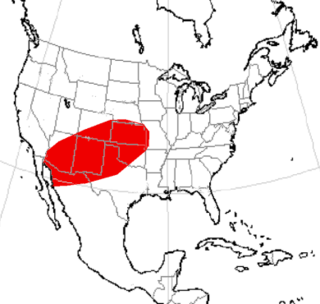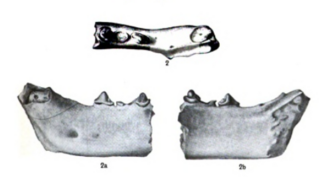
Proailurus is an extinct felid genus that lived in Europe and Asia approximately 25-30.8 million years ago in the Late Oligocene and Miocene. Fossils have been found in Mongolia, Germany, and Spain.

Pseudaelurus is a prehistoric cat that lived in Europe, Asia and North America in the Miocene between approximately twenty and eight million years ago. It is considered to be a paraphyletic grade ancestral to living felines and pantherines as well as the extinct machairodonts (saber-tooths), and is a successor to Proailurus. It originated from Eurasia and was the first cat to reach North America, when it entered the continent at about 18.5 Ma ending a 'cat-gap' of 7 million years. The slender proportions of the animal, together with its short, viverrid-like legs, suggest that it may have been an agile climber of trees.
Metailurini is an extinct taxonomic tribe of large saber-toothed cats that lived in Africa, Asia, Europe, and North America from the Miocene to the Pleistocene.
Paramachaerodus is an extinct genus of saber-tooth cat of the subfamily Machairodontinae, which was endemic to Eurasia during the Middle and Late Miocene from 15 to 9 Ma. A 2022 phylogenetic analysis suggested that the genus may be polyphyletic.

The Pantherinae is a subfamily of the Felidae; it was named and first described by Reginald Innes Pocock in 1917 as only including the Panthera species. The Pantherinae genetically diverged from a common ancestor between 9.32 to 4.47 million years ago and 10.67 to 3.76 million years ago.

Adelphailurus is an extinct genus of metailurin machairodontine (saber-toothed) cat that inhabited western North America during the middle Pliocene. It is monotypic, containing only the species Adelphailurus kansensis.

Barbourofelidae is an extinct family of carnivorans of the suborder Feliformia, sometimes known as false saber-toothed cats, that lived in North America, Eurasia and Africa during the Miocene epoch and existed for about 7.9 million years. Thought to be an independent lineage from the Nimravidae and Machairodontinae, which had all attained elongated canines, recent research argues that it may be a subfamily of the Nimravidae, extending its biochronological range into the Miocene, although this issue is not yet fully resolved.

Nimravides is a genus of extinct saber-toothed cats that lived in North America during the Late Miocene, between 10.3 and 5.332 Ma. Despite its scientific name, Nimravides does not belong to the Nimravidae, but is a true cat belonging to the family Felidae.
Pratifelis is an extinct genus of feline that lived in North America during the middle Miocene period. It contains a single species, Pratifelis martini.

Panthera blytheae is an extinct species of felid which lived during the Early Pliocene of Tibet. It has been initially suggested as the earliest known species of the genus Panthera, though its taxonomic placement has been disputed by other researchers who suggest that it likely belongs to a different genus.
Sivapanthera is a prehistoric genus of felid described by Kretzoi in 1929. Species of Sivapanthera are closely related to the modern cheetah but differ from modern cheetahs by having relatively longer brain cases, flatter foreheads, narrower nostrils and larger teeth. In many ways, skulls of Sivapanthera show similarity to that of the puma, or even those of Panthera. Scholars differ on the validity of this genus, while some think that it should be treated as a distinct genus, others think that its members should be treated as members of the Acinonyx genus, or even as subspecies of Acinonyx pardinensis.
Styriofelis is an extinct genus of Felidae known from the Miocene of Europe.
Hyperailurictis is an extinct genus of felid from Miocene North America. The Hyperailurictis species are Pseudaelurus-grade felids and thought to be the first felids in the Americas.

Leptofelis is an extinct genus of Pseudaelurus-grade felid found in Spain.
Miopanthera is an extinct genus of Pseudaelurus-grade felids.
Asilifelis is an extinct genus of small felid that lived in what is now Kenya during the Early Miocene. Despite its fragmentary remains, it is remarkable because of its small size and advanced dentition. It contains a single species, Asilifelis cotae.
Diamantofelis is an extinct genus of felids that lived in what is now Namibia during the Early Miocene. It contains a single species, Diamantofelis ferox.

Sivasmilus is a fossil genus of barbourofelid containing only a single species, Sivasmilus copei. It is known from only a single specimen, a partial mandible collected from the Chinji Formation in the Lower Siwaliks in Pakistan, estimated to be from the Miocene. The fossil was originally described in 1915 when it was assigned to the fossil feline Sivaelurus chinjiensis, but was used as the basis of a new genus and species in 1929 by Hungarian paleontologist Miklós Kretzoi. Sivasmilus copei was a relatively small, cat-like animal.
Vishnufelis is a fossil genus of feline (cat) containing only a single species, Vishnufelis laticeps. It was described by Guy Ellcock Pilgrim in 1932, based on the first cranial material of a cat found in Asia: a fragmented skull found in the Chinji Formation, which dates back to the middle Miocene.
Vinayakia is a fossil genus of proailurine felid with three species: Vinayakia nocturna, the type species, Vinayakia intermedia, and Vinayakia sarcophaga. All three species were based on fossils collected from the Miocene-aged Nagri and Chinji Formations of the Siwaliks in India and Pakistan.











